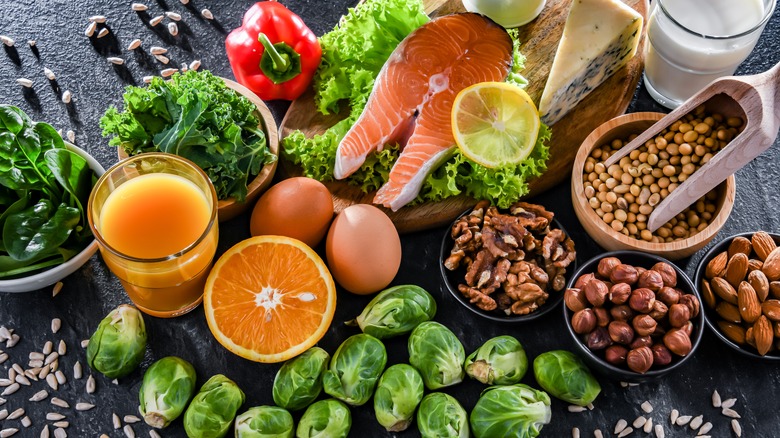The False Assumption Everyone Makes About Milk
Got milk? For many Americans over the course of the last several decades, the answer would be yes. Milk is such an expected part of the American diet, especially for children, that we often take it for granted. Despite the fact that about two-thirds of the global population, and a third of Americans, are lactose intolerant, it is common to see cartons of milk on nearly every school lunch tray. As well as children consuming the dairy product with cereal in the morning, or having a glass of it before bedtime.
We've been told that this is because milk is essential to a balanced diet. After all, dairy has a section all to itself on the food pyramid. Plus, plain milk can be great for hydration. This is largely because the calcium in milk, it's been said, is necessary for growing bones and teeth. But this assertion, while it contains an element of truth, is largely false. While calcium is a crucial nutrient for human development, there are many non-dairy sources of it that are just as valuable, if not more so, than milk.
Other sources of calcium
According to the National Institutes of Health, 1,300 milligrams of calcium per day is the recommended daily value for most individuals. While dairy products like yogurt, cheese, and plain old milk are included in the NIH's suggested sources of calcium, there's a whole boatload of other common foods that can provide just as much of this essential nutrient. This allows you to vary your diet while avoiding any gastrointestinal issues if you are lactose intolerant.
Sardines and tofu are high in calcium. Vegetables such as soybeans, spinach, kale, and bok choy also contain calcium. Seeds and nuts, like chia seeds and almonds, serve the dual purpose of being good sources of calcium as well as other nutrients like omega-3 fatty acids and magnesium. Additionally, there is an abundance of fortified foods and drinks available throughout the U.S. that provide this benefit, from fortified cereals to fortified soy milk or orange juice. In fact, since the 1920s, many foods sold in the United States, from salt to cereal, have been fortified or enriched to include additional nutrients.
Calcium content vs absorption rates
It's worth noting, however, that the usefulness of calcium content can be affected by calcium absorption, also referred to as bioavailability. For example, a cup of milk contains about 300 milligrams of calcium but only has about a 30% absorption rate, meaning you will only intake about 100 milligrams. A cup of cooked spinach has about 250 milligrams of calcium, but with a very low absorption rate of about 5%, so you will only get about 12.5 milligrams. (This is due to oxalic acid and phytic acid, two chemical compounds that inhibit absorption.)
Kale, broccoli, and bok choy have equivalent absorption rates to milk, but a lower calcium content, making them also great sources of calcium, although you will need to consume more of them. A cup of cooked kale has about 100 milligrams of calcium with a 30% absorption rate, so you would need to eat three servings to absorb the same amount of calcium as a cup of milk. However, rather than limiting your diet to large amounts of one vegetable or dairy product, this knowledge should encourage you to explore a diverse diet of plants that contribute a variety of nutrients.
Why do we think milk is the best source of calcium?
While many foods are rich in calcium, there's a reason we particularly associate milk with this nutrient. This association dates back to World War II, when the United States ramped up dairy production to send food supplies to soldiers.
Nutrition became a significant focus of the government following a wave of mass malnutrition during the Great Depression, compounded by the loss of doctors and productive members of the workforce during the subsequent war. The U.S. government had considerable incentive to keep the population healthy, which resulted in the implementation of numerous dietary guidelines aimed at reducing hunger and vitamin deficiencies. School lunches, introduced during the Great Depression, became widespread by the end of World War II. Milk, available in surplus, became an important part of those lunches.
The U.S. government actively promoted milk as a necessary part of a balanced diet to support the dairy industry, enabling it to continue meeting wartime production needs. To this day, the U.S. government remains actively involved in the promotion and protection of the domestic dairy industry through subsidies, revenue protection, and marketing. This is why it is still common to assume that milk is the ultimate source of calcium consumption, despite ample evidence to the contrary.




